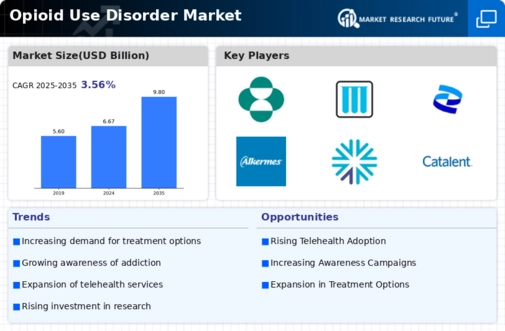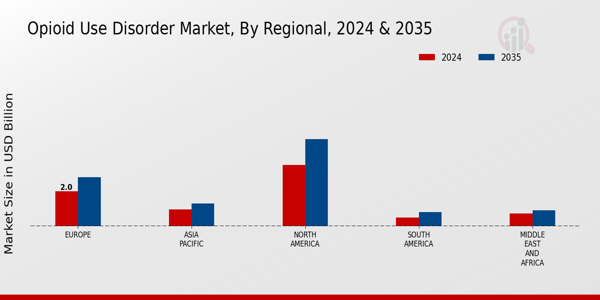Market Growth Projections
Government Initiatives and Funding
Government initiatives aimed at combating opioid use disorder significantly influence the Global Opioid Use Disorder Market Industry. Various countries are implementing policies to enhance access to treatment and support services. For instance, funding for opioid addiction treatment programs has increased, facilitating the development of innovative therapies. These initiatives not only aim to reduce the stigma associated with addiction but also promote public health awareness. As governments allocate resources to combat this epidemic, the market is expected to expand, with projections indicating a growth to 9.8 USD Billion by 2035. This financial support is crucial for advancing treatment methodologies and improving patient outcomes.
Increasing Awareness and Education
The growing awareness and education surrounding opioid use disorder play a crucial role in the Global Opioid Use Disorder Market Industry. Public health campaigns and educational programs are instrumental in informing communities about the risks associated with opioid misuse and the available treatment options. This heightened awareness encourages individuals to seek help, thereby increasing the demand for treatment services. As more people recognize the signs of addiction and the importance of early intervention, the market is likely to experience sustained growth. The ongoing efforts to destigmatize addiction further contribute to a supportive environment for those affected, fostering a culture of recovery.
Advancements in Treatment Modalities
Innovations in treatment modalities for opioid use disorder are pivotal in shaping the Global Opioid Use Disorder Market Industry. The introduction of new pharmacological agents, such as extended-release formulations and novel therapies, enhances treatment efficacy and patient adherence. Moreover, the integration of behavioral therapies alongside medication-assisted treatment has shown promising results in improving recovery rates. As the market evolves, these advancements are likely to attract investment and research, further driving growth. The anticipated compound annual growth rate of 3.56% from 2025 to 2035 underscores the potential for continued innovation in this sector, ultimately benefiting individuals struggling with opioid addiction.
Emerging Markets and Global Expansion
The expansion of treatment services into emerging markets is a significant driver for the Global Opioid Use Disorder Market Industry. Countries with previously limited access to addiction treatment are beginning to recognize the importance of addressing opioid use disorder. As healthcare infrastructure improves and awareness increases, these regions present new opportunities for market growth. The globalization of treatment approaches, including telemedicine and mobile health applications, facilitates access to care in underserved areas. This trend is expected to contribute to the overall market growth, as more individuals in emerging economies gain access to essential services and support for opioid addiction.
Rising Prevalence of Opioid Use Disorder
The increasing incidence of opioid use disorder globally is a primary driver for the Global Opioid Use Disorder Market Industry. As per recent estimates, millions of individuals are affected by opioid addiction, leading to a heightened demand for treatment options. In 2024, the market is projected to reach 6.67 USD Billion, reflecting the urgent need for effective interventions. This growing prevalence necessitates comprehensive strategies, including medication-assisted treatment and counseling services, to address the crisis. The rising awareness of opioid addiction's impact on public health further propels investments in research and development, thereby fostering market growth.






















